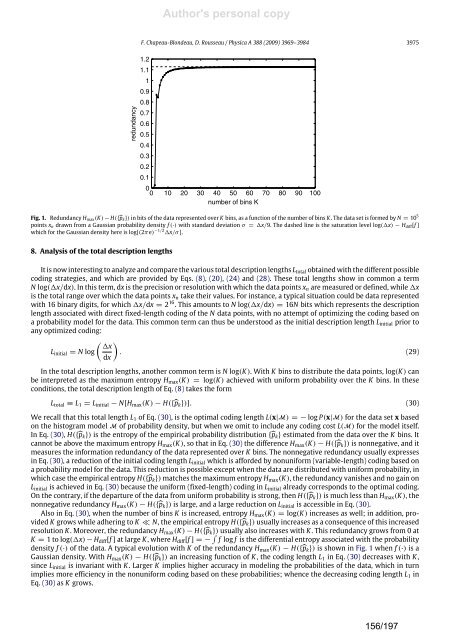a la physique de l'information - Lisa - Université d'Angers
a la physique de l'information - Lisa - Université d'Angers
a la physique de l'information - Lisa - Université d'Angers
Create successful ePaper yourself
Turn your PDF publications into a flip-book with our unique Google optimized e-Paper software.
edundancy<br />
Author's personal copy<br />
F. Chapeau-Blon<strong>de</strong>au, D. Rousseau / Physica A 388 (2009) 3969–3984 3975<br />
1.2<br />
1.1<br />
1<br />
0.9<br />
0.8<br />
0.7<br />
0.6<br />
0.5<br />
0.4<br />
0.3<br />
0.2<br />
0.1<br />
0<br />
0 10 20 30 40 50 60 70 80 90 100<br />
number of bins K<br />
Fig. 1. Redundancy Hmax(K) − H({pk}) in bits of the data represented over K bins, as a function of the number of bins K . The data set is formed by N = 10 5<br />
points xn drawn from a Gaussian probability <strong>de</strong>nsity f (·) with standard <strong>de</strong>viation σ = x/9. The dashed line is the saturation level log(x) − Hdiff[f ]<br />
which for the Gaussian <strong>de</strong>nsity here is log[(2πe) −1/2 x/σ ].<br />
8. Analysis of the total <strong>de</strong>scription lengths<br />
It is now interesting to analyze and compare the various total <strong>de</strong>scription lengths Ltotal obtained with the different possible<br />
coding strategies, and which are provi<strong>de</strong>d by Eqs. (8), (20), (24) and (28). These total lengths show in common a term<br />
N log(x/dx). In this term, dx is the precision or resolution with which the data points xn are measured or <strong>de</strong>fined, while x<br />
is the total range over which the data points xn take their values. For instance, a typical situation could be data represented<br />
with 16 binary digits, for which x/dx = 2 16 . This amounts to N log(x/dx) = 16N bits which represents the <strong>de</strong>scription<br />
length associated with direct fixed-length coding of the N data points, with no attempt of optimizing the coding based on<br />
a probability mo<strong>de</strong>l for the data. This common term can thus be un<strong>de</strong>rstood as the initial <strong>de</strong>scription length Linitial prior to<br />
any optimized coding:<br />
<br />
x<br />
Linitial = N log . (29)<br />
dx<br />
In the total <strong>de</strong>scription lengths, another common term is N log(K). With K bins to distribute the data points, log(K) can<br />
be interpreted as the maximum entropy Hmax(K) = log(K) achieved with uniform probability over the K bins. In these<br />
conditions, the total <strong>de</strong>scription length of Eq. (8) takes the form<br />
Ltotal ≡ L1 = Linitial − N[Hmax(K) − H({pk})]. (30)<br />
We recall that this total length L1 of Eq. (30), is the optimal coding length L(x|M) = − log P(x|M) for the data set x based<br />
on the histogram mo<strong>de</strong>l M of probability <strong>de</strong>nsity, but when we omit to inclu<strong>de</strong> any coding cost L(M) for the mo<strong>de</strong>l itself.<br />
In Eq. (30), H({pk}) is the entropy of the empirical probability distribution {pk} estimated from the data over the K bins. It<br />
cannot be above the maximum entropy Hmax(K), so that in Eq. (30) the difference Hmax(K) − H({pk}) is nonnegative, and it<br />
measures the information redundancy of the data represented over K bins. The nonnegative redundancy usually expresses<br />
in Eq. (30), a reduction of the initial coding length Linitial which is affor<strong>de</strong>d by nonuniform (variable-length) coding based on<br />
a probability mo<strong>de</strong>l for the data. This reduction is possible except when the data are distributed with uniform probability, in<br />
which case the empirical entropy H({pk}) matches the maximum entropy Hmax(K), the redundancy vanishes and no gain on<br />
Linitial is achieved in Eq. (30) because the uniform (fixed-length) coding in Linitial already corresponds to the optimal coding.<br />
On the contrary, if the <strong>de</strong>parture of the data from uniform probability is strong, then H({pk}) is much less than Hmax(K), the<br />
nonnegative redundancy Hmax(K) − H({pk}) is <strong>la</strong>rge, and a <strong>la</strong>rge reduction on Linitial is accessible in Eq. (30).<br />
Also in Eq. (30), when the number of bins K is increased, entropy Hmax(K) = log(K) increases as well; in addition, provi<strong>de</strong>d<br />
K grows while adhering to K ≪ N, the empirical entropy H({pk}) usually increases as a consequence of this increased<br />
resolution K . Moreover, the redundancy Hmax(K) − H({pk}) usually also increases with K . This redundancy grows from 0 at<br />
K = 1 to log(x) − Hdiff[f ] at <strong>la</strong>rge K , where Hdiff[f ] = − f log f is the differential entropy associated with the probability<br />
<strong>de</strong>nsity f (·) of the data. A typical evolution with K of the redundancy Hmax(K) − H({pk}) is shown in Fig. 1 when f (·) is a<br />
Gaussian <strong>de</strong>nsity. With Hmax(K) − H({pk}) an increasing function of K , the coding length L1 in Eq. (30) <strong>de</strong>creases with K ,<br />
since Linitial is invariant with K . Larger K implies higher accuracy in mo<strong>de</strong>ling the probabilities of the data, which in turn<br />
implies more efficiency in the nonuniform coding based on these probabilities; whence the <strong>de</strong>creasing coding length L1 in<br />
Eq. (30) as K grows.<br />
156/197


